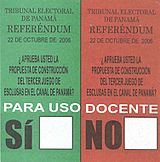2006 Panama Canal expansion referendum facts for kids
The Panama Canal expansion referendum was a special vote held in Panama on October 22, 2006. Citizens were asked if they approved a big plan to make the Panama Canal larger. Most people voted "yes" to this important project.
Contents
What Was the Panama Canal Expansion Vote?
This vote was about a huge plan to make the Panama Canal bigger. The project aimed to double the canal's capacity. This would allow more ships to pass through. It was the biggest change to the Canal since it was first built.
Why Was This Vote Needed?
Panama has a special rule in its Constitution. This rule says that any big plan to build new locks for the Canal must be approved by several groups. First, the country's leader, the executive branch, had to agree. Then, the National Assembly of Panama, which is like their parliament, had to approve it. Finally, the people of Panama had to vote on it in a national referendum. This vote had to happen at least three months after the National Assembly approved the plan.
What Was the Big Idea?
The plan to expand the Panama Canal was presented on April 24, 2006. Martín Torrijos, who was the President of Panama at the time, shared the idea with everyone. Experts from the Panama Canal Authority (ACP) had studied the plan for many years.
The main goal was to add a new lane for ships. This new lane would have its own set of locks. Here are some of the key parts of the project:
- Two new lock systems were to be built. One would be on the Atlantic side and one on the Pacific side.
- Each new lock system would have three chambers. These chambers would also have special basins to save water.
- New channels would be dug to reach the new locks. Existing channels would also be made wider.
- The shipping channels would be made deeper. Also, the highest water level of Gatún Lake would be raised.
The Panama Canal Authority estimated the project would cost about US$5.25 billion. They planned to pay for it by increasing the fees ships pay to use the Canal. The construction was expected to take about 7 to 8 years.
Panama's government leaders, called the Cabinet, approved the project. Then, on July 14, the National Assembly voted. They all agreed to the expansion plan. The Assembly also passed a law to hold the national vote. The referendum took place on October 22, 2006.
What Did People Vote On?
The ballot for the vote was simple. It was split into two parts. On the left side, it said Sí (Yes) with a green background. On the right side, it said No with a red background. The question at the top of the ballot asked:
- Do you approve the proposal of construction of a Third Set of Locks on the Panama Canal?
What Did People Think?
There were strong opinions on both sides of the expansion plan. Some people were against it. They worried about the government's cost estimates. They also feared that corruption might cause problems for the project.
However, the government worked very hard to convince people to vote "yes." They said that expanding the Canal was the most important update in its history. Officials told people that a "yes" vote was a vote for the future of Panama's children. They warned that if the Canal wasn't expanded, ships might find other routes. This could hurt Panama's growing economy.
How Did the Voting Go?
The voting day went smoothly. There were no major problems that could affect the results. However, not everyone who could vote did. Only 43.32% of registered voters showed up. Voting was open from 7 AM to 4 PM. Anyone still in line at 4 PM was allowed to cast their vote.
Unofficial results were announced quickly. Just 30 minutes after voting ended, the Electoral Tribunal started sharing them. They had centers that collected results from each voting place. These results were sent to Panama City. By 6 PM (two hours after voting ended), about 25% of the votes were counted. It was clear then that the project would likely be approved. The official results took three days to be finalized. This was because all the official declarations had to come from across the country to Panama City.
What Were the Results?
The people of Panama clearly voted to expand the Canal. Here are the final numbers:
| Choice | Votes | % |
|---|---|---|
| For | 705,144 | 77.80 |
| Against | 201,247 | 22.20 |
| Invalid/blank votes | 17,638 | – |
| Total | 924,029 | 100 |
| Registered voters/turnout | 2,132,842 | 43.32 |
| Source: Direct Democracy | ||
What Did Leaders Say?
Many people shared their thoughts after the vote:
- President Martín Torrijos said this was a very important choice for his generation. He believed the decision should include everyone in Panama. This meant those who voted "yes," those who voted "no," those who didn't vote, and even those too young to vote.
- Taiwan congratulated Panama on the vote. They even offered to help with the Canal expansion.
- A shipping group from Denmark, Dansk Rederiforening, was happy with the decision. They thought the expansion would be good for shipping around the world.
- The U.S. Ambassador, William A. Eaton, said the expansion would make shipping costs cheaper. He believed this would help the U.S. economy.
- John LaRue, who works at the U.S. port of Corpus Christi, Texas, also saw good things. He said the project would improve trade. He thought it would help ports on the Gulf Coast.
See also
 In Spanish: Referéndum de ampliación del Canal de Panamá de 2006 para niños
In Spanish: Referéndum de ampliación del Canal de Panamá de 2006 para niños


